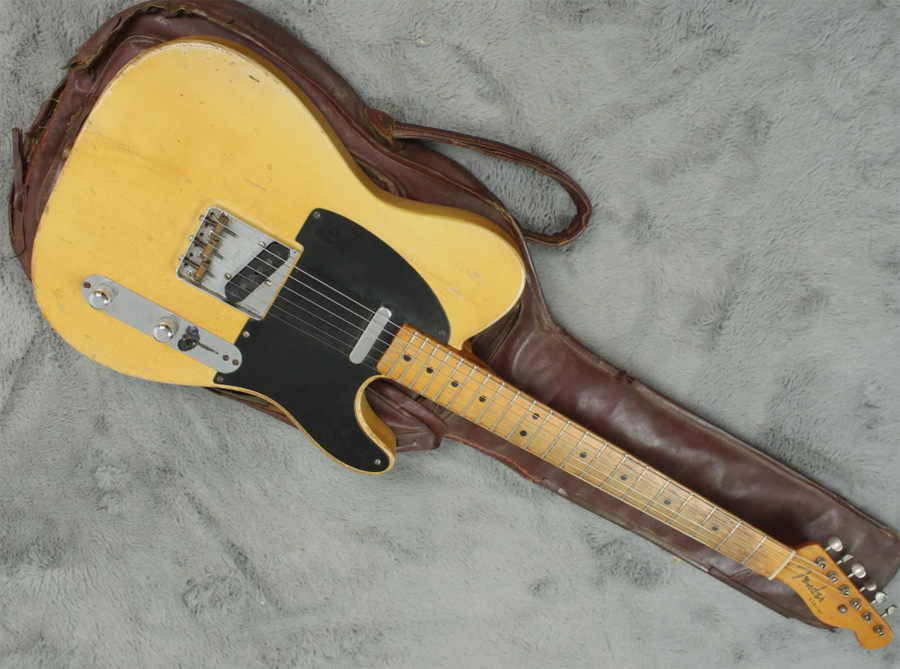One of Fender’s most enduring triumphs is the Telecaster. Read on to find out how it became an essential staple of guitar music.
The Telecaster is almost as old as the electric guitar itself. And since it arrived more than 70 years ago, it has maintained a strict adherence to its shape and core features.
But this traditionalism masks an intriguing history of innovation. The guitar world tends to fetishise the vintage (the Tele isn’t immune), but this model has moved with the times while paying tribute to its roots. Read on to trace the evolution of Fender Telecaster.

Simplicity and style
Most guitar aficionados rightly recognise that the Telecaster was intrinsic to the popularisation of the electric guitar. Its DNA is recognisable in hundreds of models that came after. But if the Tele is at the top of the family tree, what was its ancestor?
Well, the Hawaiian steel guitar, of course.
Fender had been making that style of guitar since the mid-’40s and a couple of key touches made it over to the new Telecaster. The iconic “ashtray” bridge cover, Kluson tuners, and the fitting of the bridge pickup and bridge itself into one modular unit. Simple, practical, and elegant.
The controls were similarly sparse and once the design had been established in 1952, we saw the configuration that all Tele players are familiar with: a neck pickup, a bridge pickup, and a three-way switch for running each of them, plus, a combination of the two.
Perfectly timed to get on the rock ‘n’ roll train, the rugged, affordable, and handsome new model from the Fender factory was a hit. The burgeoning popularity of newly electrified blues and country sealed the Tele’s fate: it became an indispensable tool in the studio and on the stage.

British Invasion
In the ’60s rock ‘n’ roll took a back seat in America. The next generation of rockers came from across the Atlantic. These upstarts — who, incidentally, dined out on American blues, RnB, and rock ‘n’ roll in the ’50s — came to the States all guns blazing. Their weapon of choice? The Telecaster, of course.
British guitar gods of the ’60s: think Eric Clapton, Jimmy Page, Pete Townshend, George Harrison (you can see him below rocking his custom rosewood model), and more, all slung this iconic model around their shoulders at some point in their glittering careers. And along with a half-burnt cigarette, the other item that Keith Richards from The Rolling Stones still has welded to his hands is a Telecaster.
If the world was awoken to the voice of this guitar in the ’50s, the ’60s was the decade in which it was seared into our collective memory. An era of astronomical advances in the studio had brought out the best in the Tele and provided a platform to launch new explorations.
Changing it up
Despite knowing they had a champion on their hands, the ’70s ushered in an era of Telecaster innovation for Fender. But why? Because players were doing it anyway.
One of the most popular player mods that Fender made official was the incorporation of humbucking pickups. That bitey single-coil is one of the key tonal signatures of the Tele, but as it turns out, the fat, juicy tone of a humbucker was just too good to ignore.
The Telecaster Custom hit the streets in ’72 with a humbucker in the neck position. But Fender went all-out the year after with the Telecaster Deluxe — a twin humbucker beast that was perfect for the ever-expanding palette of rock tones.
Still innovating
Despite going through a pretty rough time in the ’80s, the Fender flag was still flying. Punks, new wave, and mega pop-rock acts like The Police whole-heartedly adopted the Tele and added to its legend. Fender’s presence in Japan became bigger, the CBS reign ended and Fender got back to doing what they do best: building exciting and high-quality instruments.
Waves upon waves of new artists turned to the Telecaster for inspiration. The bitey tones of Blur’s Graham Coxon were shaped by this guitar, as well as the avant-rock of Radiohead’s Jonny Greenwood. Australian players like Courtney Barnett chiselled out pitch-perfect riffs on the Tele to go with her lyrical musings, while English virtuoso Anna Calvi forms cinematic masterpieces with this iconic axe at its core.
Many innovative interpretations of the Telecaster followed Fender’s period of turbulence, but perhaps none are as audacious as the Acoustasonic Player model. Combining the archetypal tones of the Tele with intriguing blends of electric and acoustic, and finally, a headlong dive straight into the pure acoustic world is daring enough. To combine all these flavours in one guitar, however, is a stroke of genius.
For all these reasons: the iconic players, that instantly recognisable tone, as well its history of innovation — it’s little wonder that it’s still exciting to pick up a Tele and let it sing.
To find more about the new Fender Acoustasonic Player Telecaster, head over to the Fender website.



